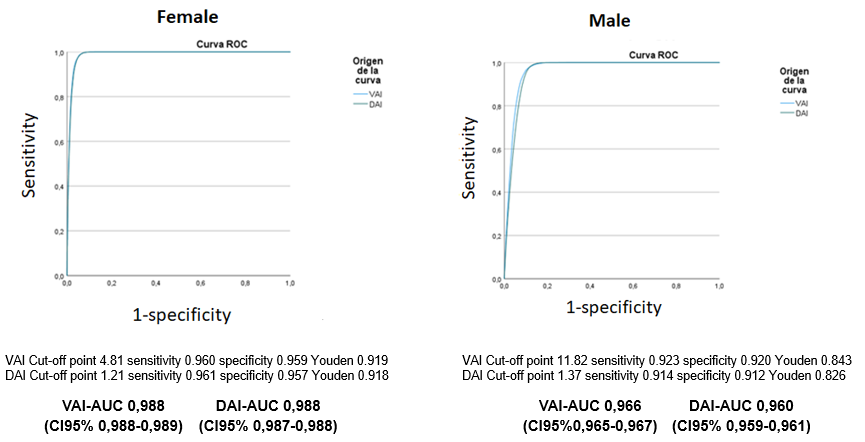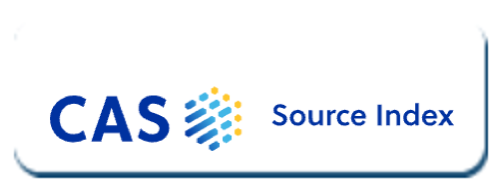Visceral and dysfunctional adiposity indexes: Relationship with cardiometabolic risk factors
DOI:
https://doi.org/10.5281/zenodo.7757760Keywords:
Cardiovascular risk, dysfunctional adiposity, metabolic syndrome, occupational health, visceral adiposityAbstract
Objective: Obesity is a worldwide disease in which visceral obesity is related to increased cardiometabolic risk. The aim of this study was to estimate the associative capacity of visceral adiposity index and dysfunctional adiposity index on cardiometabolic risk in the working population.
Material and methods: Descriptive study of 418,343 workers during health surveillance in their companies. VAI and DAI were calculated according to their equations and cardiometabolic risk with arterial hypertension, diabetes and atherogenic dyslipidemia, lipid triad, diabesity, and hypertriglyceridemic waist. Mean VAI and DAI values and associative capacity with ROC curves were calculated. The statistical program used SPSS 27.0, with statistical significance p<0.05.
Results: Percentage values of all parameters and assessment methods used are higher in men than in women (p<0.0001) Mean values of VAI are higher than those of DAI and higher in men (p<0.0001). VAI and DAI show high associative capacity for atherogenic dyslipidemia, lipid triad and hypertriglyceridemic waist in both sexes with the area under the AUC curve>0.9 in all cases. In diabesity only AUC>0.8 values are obtained for VAI and for diabetes, both VAI and DAI only in women exceed AUC>0.8, in men In HT, VAI, and DAI do not show associative capacity in men or in women (AUC<0.7).
Conclusions: Cardiometabolic risk estimation is different in men and women and varies according to the method used. Adiposity indices VAI and DAI show high associative capacity in cardiometabolic risk, especially in atherogenic dyslipidemia, lipid triad, and hypertriglyceridemic waist in both sexes.
References
Caballero B. Humans against Obesity: Who Will Win? Adv Nutr. 2019;10(suppl 1):S4-S9.
Tchernof A, Després JP. Pathophysiology of human visceral obesity: an update. Physiol Rev. 2013;93(1):359-404.
Bilgin Göçer D, Baş M, Çakır Biçer N, Hajhamidiasl L. Predicting metabolic syndrome by visceral adiposity index, body roundness index, dysfunctional adiposity index, lipid accumulation product index, and body shape index in adults. Nutr Hosp. 2022;39(4):794-802.
Lemieux I, Poirier P, Bergeron J, Alméras N, Lamarche B, Cantin B, et al. Hypertriglyceridemic waist: a useful screening phenotype in preventive cardiology? Can J Cardiol. 2007;23 (suppl B):23B-31B.
Ley 31/95, de 8 de Noviembre, de Prevención de Riesgos Laborales. Boletín Oficial del Estado núm. 269, de 10 de noviembre de 1995.
Bestehorn K, Smolka W, Pittrow D, Schulte H, Assmann G. Atherogenic dyslipidemia as evidenced by the lipid triad: prevalence and associated risk in statin-treated patients in ambulatory care. Curr Med Res Opin. 2010;26(12):2833-9.
López González AA, Ramírez Manent JI, Vicente Herrero MT, García Ruiz E, Albaladejo Blanco M, López Safont N. Prevalence of diabesity in the Spanish working population: influence of sociodemographic variables and tobacco consumption. An Sist Sanit Navar. 2022;45(1):e0977.
American Diabetes Association. Diagnosis and classification of diabetes mellitus. Diabetes Care. 2010;33(Suppl 1):S62-9
Mohebbi V, Aramayo A, Morales J. Determination of scales related to cardiovascular risk and fatty liver in 5.370 spanish farmers. Academic Journal of Helth Sciences 2021;36(2):26-33.
Amato MC, Giordano C, Galia M, Criscimanna A, Vitabile S, Midiri M, et al. Visceral Adiposity Index A reliable indicator of visceral fat function associated with cardiometabolic risk. Diabetes Care. 2010;33(4):920-2.
Reyes Barrera J, Sainz Escárrega VH, Medina Urritia AX, Jorge Galarza E, Osorio Alonso H, Torres Tamayo M, et al. Dysfunctional adiposity index as a marker of adipose tissue morpho-functional abnormalities and metabolic disorders in apparently healthy subjects. Adipocyte 2021;10(1):142-52.
Ivković-Lazar T. Savremena dijagnostika specificne distribucije masnog tkiva Current diagnostic methods of the specific distribution of adipose tissue. Med Pregl. 2000;53(11-12):584-7.
Canadian Health Measures Survey results – oral health statistics, 2007-2009. Chronic Dis Can. 2010;30(4):117-8.
Lemieux I, Alméras N, Mauriège P, Blanchet C, Dewailly E, Bergeron J, et al. Prevalence of 'hypertriglyceridemic waist' in men who participated in the Quebec Health Survey: association with atherogenic and diabetogenic metabolic risk factors. Can J Cardiol. 2002;18(7):725-32.
Girard Mauduit S. The lipid triad, or how to reduce residual cardiovascular risk? Ann Endocrinol (Paris). 2010;71(2):89-94.
Bestehorn K, Smolka W, Pittrow onnalagadda, V.G. Prediabetes with Hypertension and Dyslipidemia: Are They Triad of Future Cardiovascular Risk? Cardiovasc Drugs Ther. 2019;33:763.
LeBlanc S, Coulombe F, Bertrand OF, Bibeau K, Pibarot P, Marette A, et al. Hypertriglyceridemic Waist: A simple marker of high-risk atherosclerosis features associated with excess visceral adiposity/ectopic fat. J Am Heart Assoc. 2018;7(8):e008139.
Janghorbani M, Aminorroaya A, Amini M. Comparison of Different Obesity Indices for Predicting Incident Hypertension. High Blood Press Cardiovasc Prev. 2017;24(2):157-66.

Downloads
Published
How to Cite
Issue
Section
License
Copyright (c) 2023 Journal of Clinical Trials and Experimental Investigations

This work is licensed under a Creative Commons Attribution 4.0 International License.
![]() The journal is licensed under a Attribution4.0 International (CC BY 4.0).
The journal is licensed under a Attribution4.0 International (CC BY 4.0).










